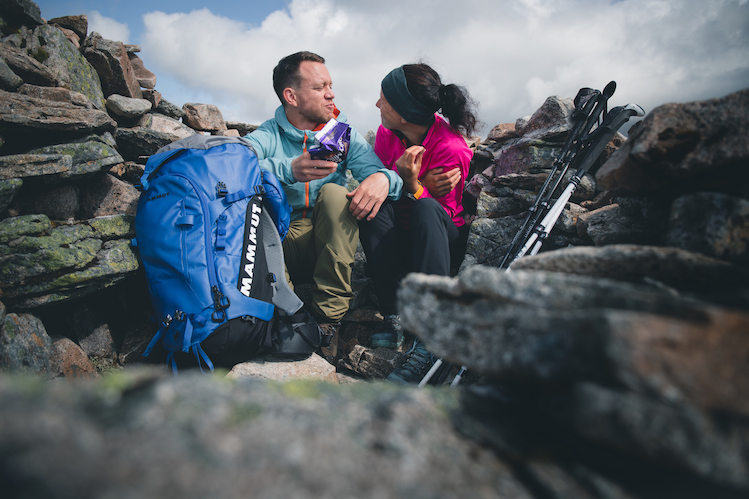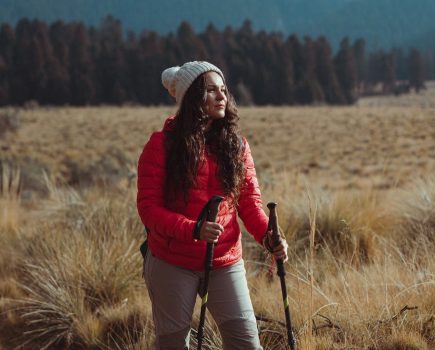Good food helps you walk further, feel better and recover more quickly. Plas y Brenin instructor Iona Pawson explains the basics of nutrition in the mountains.
Main image: enjoying lunch during a day on Buachaille Etive Mor, Scotland. Photo: Edward Fitzpatrick
Firstly, nutrition is personal. Our bodies are all different, we have all exercised and therefore trained ourselves (whether purposefully or not) to use foods in differing ways. This doesn’t mean we can’t change what we do, train our body differently for the future or follow some general key principles. Embrace every day out in the hills as a time to experiment with what works for you when doing a particular activity (although I wouldn’t recommend trying radical new ideas on a multi-day expedition, just in case this backfires on you and your team).
Secondly, nutrition is fuel for the body. Good nutrition will enable you to have a better time in the mountains. Below are some ideas to consider when organising your trips.
Carbohydrates
Carbohydrates are easier to digest when moving. Eat a mixture of sugars and starches – a jam sandwich, for example – and save sugary foods for the last part of the day so you don’t have sugar highs and lows throughout the day
Fats
When the weight of your bag matters, carrying food that has more calories per 100g becomes crucial. In terms of highest calories per gram of food, peanuts are 580 calories per 100g, olive oil is 850 and butter is 700. Eat more fat in the evening for a warmer night’s sleep, particularly when winter camping. Most people’s body will require more training to utilise fats more readily in the day.
Proteins
Protein is good for muscle recovery. Eat more at the end of a longer day, especially if the next day is long too.
Vitamins and minerals
Vitamins and minerals are particularly important for multi-day trips. They can help to balance electrolytes and sodium levels in the body.
Water
Drink when you’re thirsty. Walking more slowly in the hills equates to less breathing and less sweating, which means less water loss. Manage clothing for less sweating in the hills and schedule your walk to suit the temperature of the day – don’t walk in the midday sun during a heatwave, get up earlier and finish for a late lunch. Finally, drink more in the morning and evening and keep some water on your bedside table.
Iona’s food diary: what a day in the mountains looks like for me
As a professional and relatively petite female, it can be easy to forget that I don’t require the same number of calories as somebody else in the mountains. This is down to a number of elements, including base metabolic rate, efficiency of movement, training and adaption to the sport, and pack weight.
Learn what works for you, your friends and team members. I still can’t quite get over the fact that my boyfriend needs almost double the amount of food and water as I do when we go into the hills to survive and enjoy the journey!
Here’s what I’ll usually eat during a day of instructing in the mountains.
First thing
- A glass of water / juice / cup of tea.
Breakfast
- A mug of coffee: I like one per day in the morning. Very occasionally I’ll take energy chews with caffeine in for a super long day in the mountains, but I don’t want to rely on needing a caffeine fix to concentrate later in the day or have to carry a big flask in addition to my water to get my daily coffee.
- Banana oat pancakes: these are my go-to breakfast before a long day in the hills. They contain a range of foods and some fruit too. You can top them with summer fruits, bacon and maple syrup, or yogurt and raspberry jam.
- On a cold winter’s day, nothing beats a full English breakfast in the morning – but be careful not to go too huge. While it soon burns off breaking trail in the snow and keeping warm, I hate feeling too full at the start of the day. It makes everything harder!
Second breakfast
Yes, you read that right! On occasion I will go for a run or bike ride before work, or need a breakfast that’s a bit easier to eat at the start of my day.
- Summer smoothie: one banana, yogurt, milk, oats, summer fruits blended and drunk during our morning work meeting with other instructors.
During the day
- Sandwiches: my favourite is cheese and ham for a balanced sandwich. However, I try to pick something that has slow and fast release energy and tastes good – something I will want to eat in torrential rain or gale force winds.
- Fruit / dried fruit: in the summer months a juicy apple is incredible. Homegrown strawberries in a Tupperware container are a pleasure to eat too. The remainder of the year I adore dried bananas, which we dehydrate at home.
- Peanuts or a small bag of trail mix: good for eating on the move and easily stored in a pocket.
- Cake / goodies: a cake towards the end of the day is a real pick me up, providing a sugar burst for that final bit of energy needed to get you back to the minibus. They are also amazing at just making you feel good. Other favourites are jelly babies and party rings.
- Other things I eat on days off when work doesn’t provide my lunch include little risotto portables, peanuts, gingerbread hard bars and rice pudding.
Tea and cakes
Nothing beats a good cake and a cup of tea to refuel and rehydrate. Whilst the Brenin cake is mildly addictive, it fills the gap between lunch and supper – just enough to get me home or ready for a climb after a day of instructing.
Evening meal
Some good, balanced home-cooking, for example…
- Spaghetti bolognese with extra vegetables snuck in there.
- I love grating carrots and courgettes into evening meals. They bulk it up, taste good and get rid of vegetable gluts from our garden.
- Who doesn’t love a pudding? I try to mix them up between gooey chocolate puddings, fresh fruit and baked goodies.
Multi-day journeys: 12 nutrition tips
When it comes to longer multi-day and backpacking journeys, food becomes even more important.
- Variety: try to take a range of foods so you don’t get bored. One of my friends once decided to only take peanuts for five weeks’ worth of lunches! After a couple of days, he was begging to swap with anyone he could find on the mountain.
- Colourful foods: this is the reason I take party rings! Sometimes the smallest amount of colour can be a real pick me up, particularly if you don’t have any fresh food on your trip.
- Dehydrated vegetables: these are really difficult to source in the UK, so I make my own in a dehydrator and add them to my dehydrated food packets.
- Cheese and butter: a little bit for every evening meal on a cold winter journey. These add fat and flavour to your meal.
- Spices and herbs: these can help you transform a meal with very little effort!
- Concentrated juice: if you struggle to drink enough water during the day and in the tent / hut, consider adding a few drops of juice to your bottle.
- Effervescent vitamin tablets: a way to get your vitamins in whilst hydrating.
- Dehydrated food: my current favourite is Firepot – it tastes of something, has real ingredients, the calories aren’t only made up with oil… and they also have a great range for those with dietary requirements (they even do bespoke meals for folk with particular dietary needs). You can make your own dehydrated meals too.
- Consider cooking something at lunch time: it’s a hassle, but stopping to boil water to make a soup or a ready pasta meal in addition to your snacks is a great way to enforce a longer stop, really take time to rehydrate, eat and enjoy your surroundings. I begrudgingly began doing this whilst bikepacking and loved it.
- Make your own energy bars or cake and pre-package into daily portions: the taste of home in a remote and wild place is so satisfying and can instantly make you feel better.
- Remember to consider where you are eating: are you able to stop for lunch and cook? Does everything need to fit in a jacket pocket for lunch? Will you have boiling water and at what times of the day? Does your cooking plan match your team members? Is your breakfast liable to fill the tent with bits of Ready Brek if you accidentally breathe on it?!
- And finally: a controversial one – consider taking ‘real food’ and try baking your own bread, making pasta sauces and other goodies in the field. If the weight of your pack isn’t an issue and you have lots of downtime in the evenings, then real cooking on an expedition can be fun and healthier.








